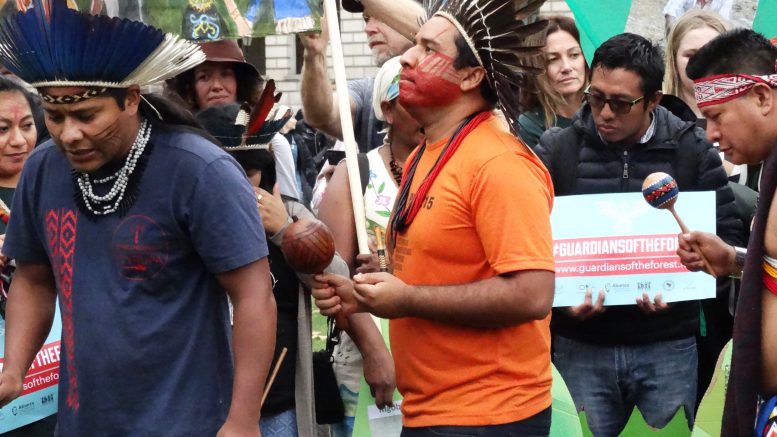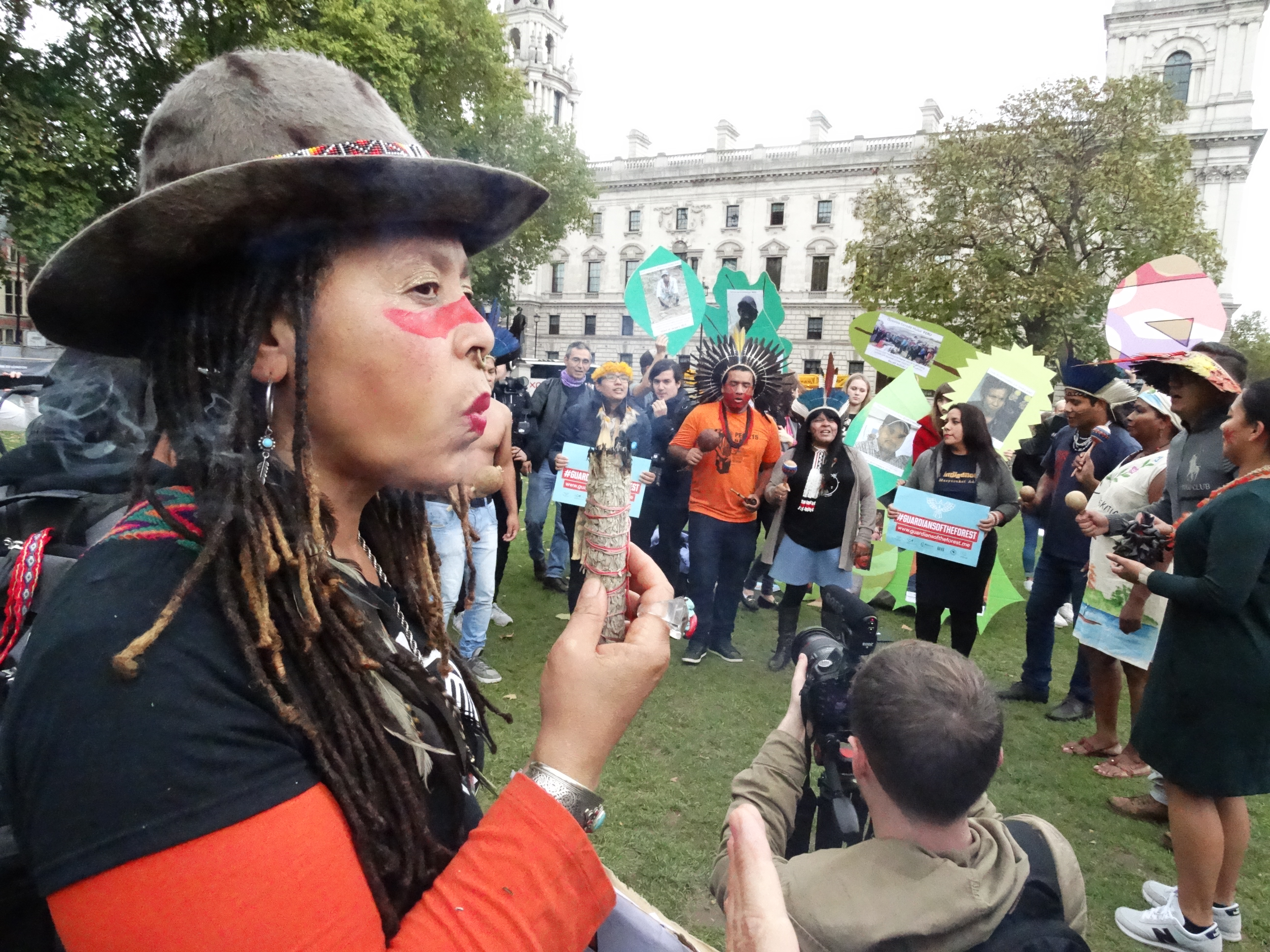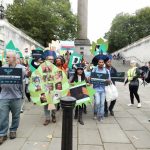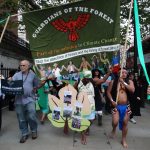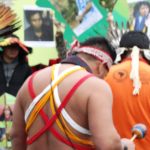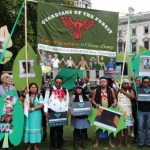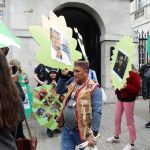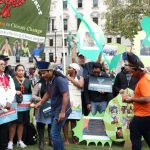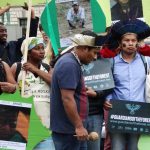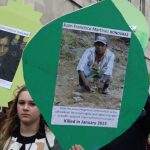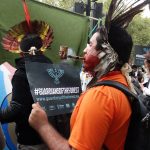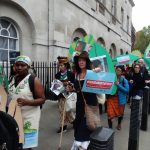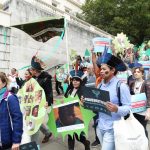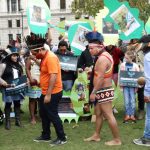Wearing their traditional headwear and clothes, they came from Brazil, Indonesia, Peru and Panama. Bringing the discussion to the capital was part of their wider tour of European cities by bus on their tour to Bonn, where #COP23 climate discussions will take place.
They sing, dance and share music with London activists on Parliament Square as part of a peaceful demonstration to tackle climate change.
Yet amongst the music, vibrancy and coming together of a native cultures and the British public – they come bearing a serious message. We must stand beside them to protect the worlds forests, this involves being mindful of our consumption and campaigning for greener climate funding within our own government.
Speaking at the event, Mina Setra, The Indigenous Peoples’ Alliance of the Archipelagos from Indonesia tells the Voice of London:
“Your investments are responsible for this problem. Your governments need to know that crime against the environment is crime against humanity. We need government to start making necessary measures to protect our land.”
Research with local indigenous communities called money where it matters discovered that out of £127 bn in international investment to reduce carbon emissions, only two per cent of the fund was dedicated to reducing deforestation. The study also revealed long term protection will answer 40 per cent of the climate change solution.
#COP23; remember #Indigenous communities and their traditional knowledge offer approach to tackle #climatechange https://t.co/y3nEwb8QIx pic.twitter.com/1S8jv10uaZ
— If Not Us Then Who (@IfNotUs_ThenWho) November 17, 2017
This fight for land has been going on for decades, yet they have little recognition amongst climate change professionals, who rarely involve them in the global initiative to reduce our carbon emissions.
Leader Mina Setra goes on to tell the Voice of London:
“My land was stolen for a reservation site. Our river is dry now, the water is no longer theirs to drink from. This is the situation that has brought us here. 80 per cent of the best forests are in the hands of the indigenous, we are proven to be the protectors of the forest. Yet governments fail. They destroy forests.”
“We are asking you to curb your consumption just a little” says one of the activists on parliament square. By doing so we support those protecting the worlds forests as part of a wider initiative to combat climate change globally. They join as part of a group called If Not Us Then Who.
16,000 scientists, from 184 countries, have signed a dire warning to humanity. If we don't increase action on #climatechange the planet will sustain "substantial and irreversible" damage: https://t.co/WPDsA1SP8g#ActOnClimate #cdnpoli #NoKXL #StopKM #COP23 pic.twitter.com/pf8zdzHurM
— Mike Hudema (@MikeHudema) November 16, 2017
So what exactly are they asking for?
– International recognition for their land rights
– Protection of their environmental activists
– Funding for the preservation of the worlds forests
– Awareness of our consumer actions
Investment matters
Is the government doing enough to tackle climate change?
There’s little transparency about where exactly all of our climate funding it going. But what we do know, is that it’s not going where it should. The money where it matters report suggests that governments and donors invested 39 times more to promote agriculture and land-intensive development than they did in stopping the destruction of the forests.
Charlotte Streck, co-founder of Climate Focus tellsThe Voice of London:
“Forests hold so much potential in the effort to limit climate change, and yet there’ a seemingly endless supply of money to help tear them down… we need to invest much more in keeping forests standing rather than in activities to destroy them.”
Due to lack of funding, and recognition of the cruciality of their role within the climate talks, many human rights defenders have been murdered in order to have their voices silences.
Photo gallery: Yasmin Dahnoun
How dangerous is environmental activism?
Crime against environmental activists is an all time high – in 2016, 200 activists were killed – according research conducted by Global Witness. By early October this year, another 153 environmental defenders had been murdered.
More than 40 per cent of these activists were indigenous leaders. Latin America, home to some of richest resources in the world, is currently recognised by the UN as one of the most dangerous places in the world for environmental activists. Global Witness project aims to start recording more of these deaths per year.
With the increasing lack of natural resources such as oil and gas, there is a scramble amongst corporations who are starting to reach out to untouched indigenous areas which contain large amounts of natural resources, and they are prepared to commit crime against anyone in their way, and there is little done to penalise these people. There is no deterrent.
Sonia Guajajara goes on to tell The Voice of London about the violation against her people:
“If theres still forests standing today. It’s because we exist. We are being brutally attacked by the forces and the profit of agribusiness and the model of development that has been invented here in the UK. The destruction of the Rio dulce in Brazil was not an accident. It was a crime… we saw the death of a man and a young child who was wounded for trying to save their land.”
Indigenous leaders hope that their role in the environmental protection of our planet will be recognised by world leaders and supported by an international community within the coming COP23 summit which will be taking place in Bonn. They prey that one day they will live without the threat of violence that has become the reality of their everyday existence.
The demo in pictures
Photo gallery: Yasmin Dahnoun
Like this article? You may also be interested in these stories:
Read more about the clean air fight in London
Ever wanted to live in the wild? Find out more about the benefits
The healing power of Mother Nature
Words: Yasmin Dahnoun | Edited: Joshua Hornsey & Ainaa Mashrique.

